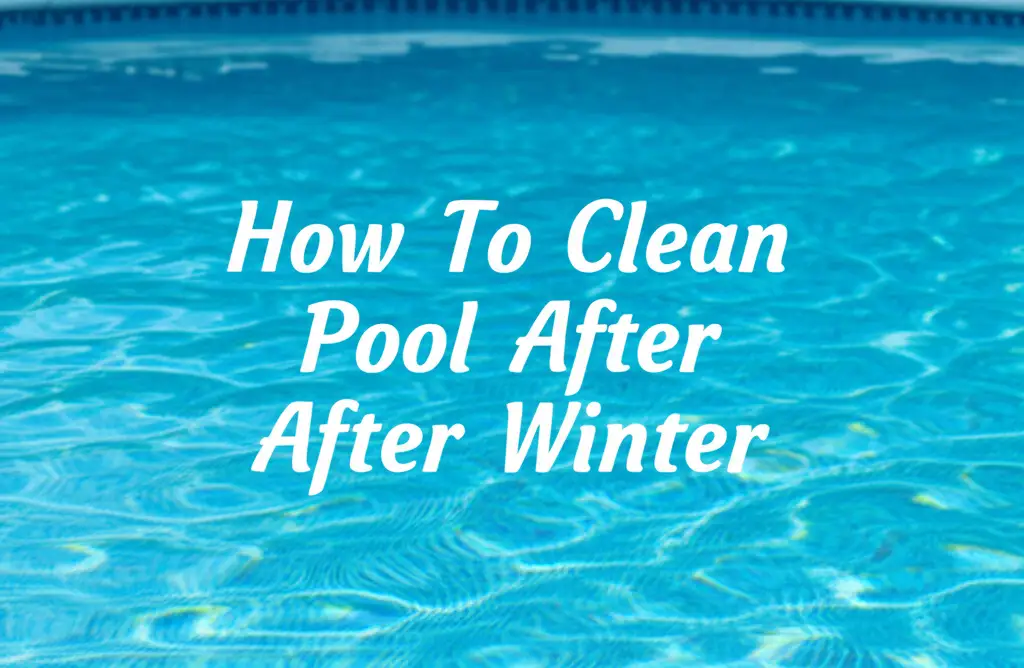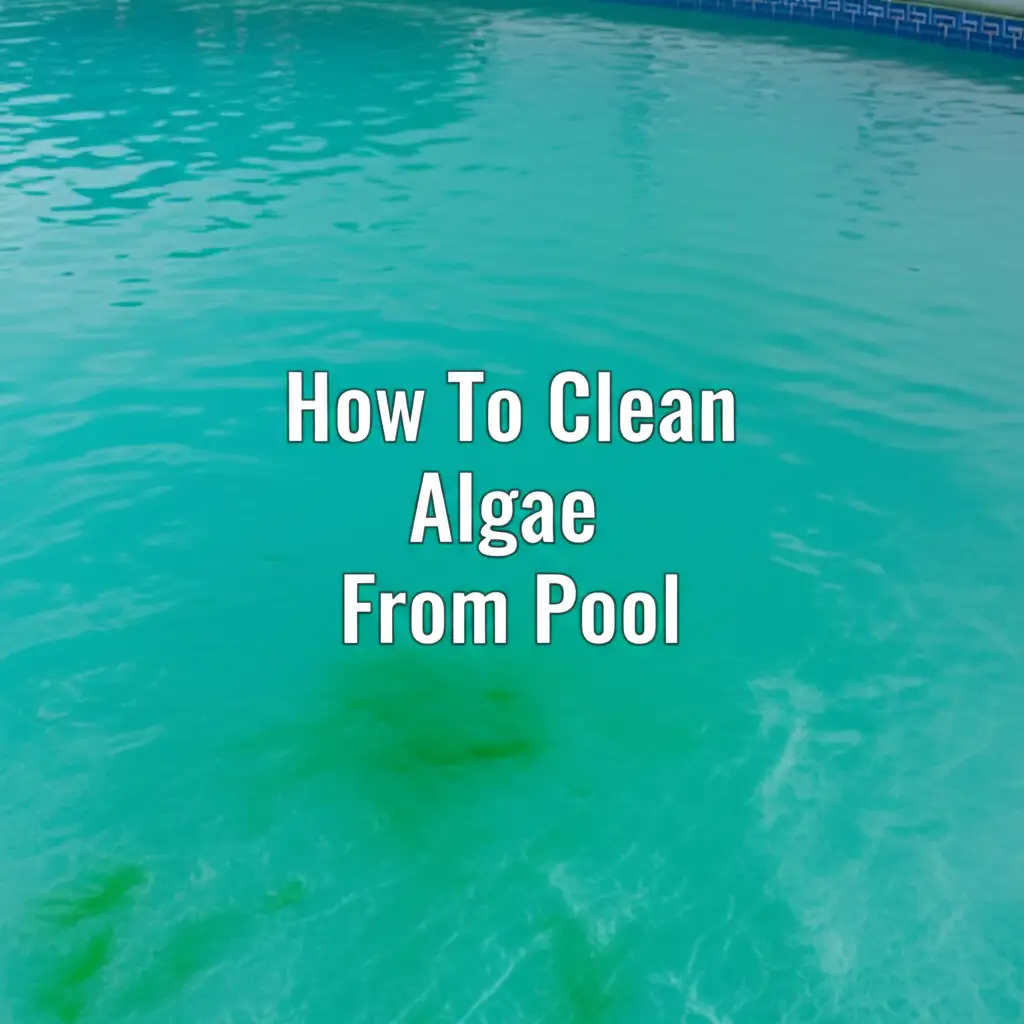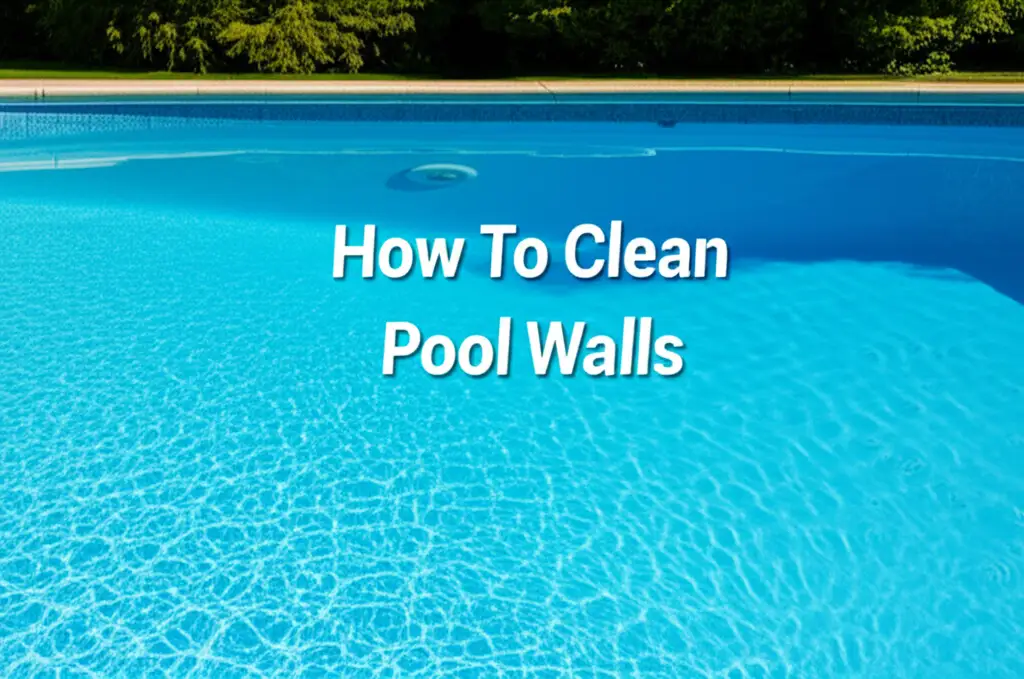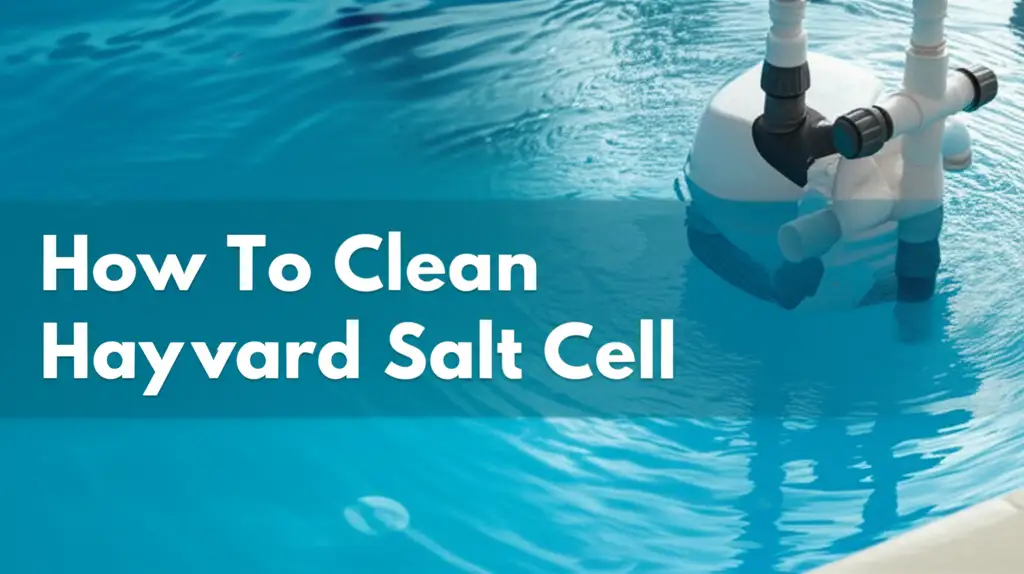· Pool Maintenance · 19 min read
How To Clean Above Ground Pool
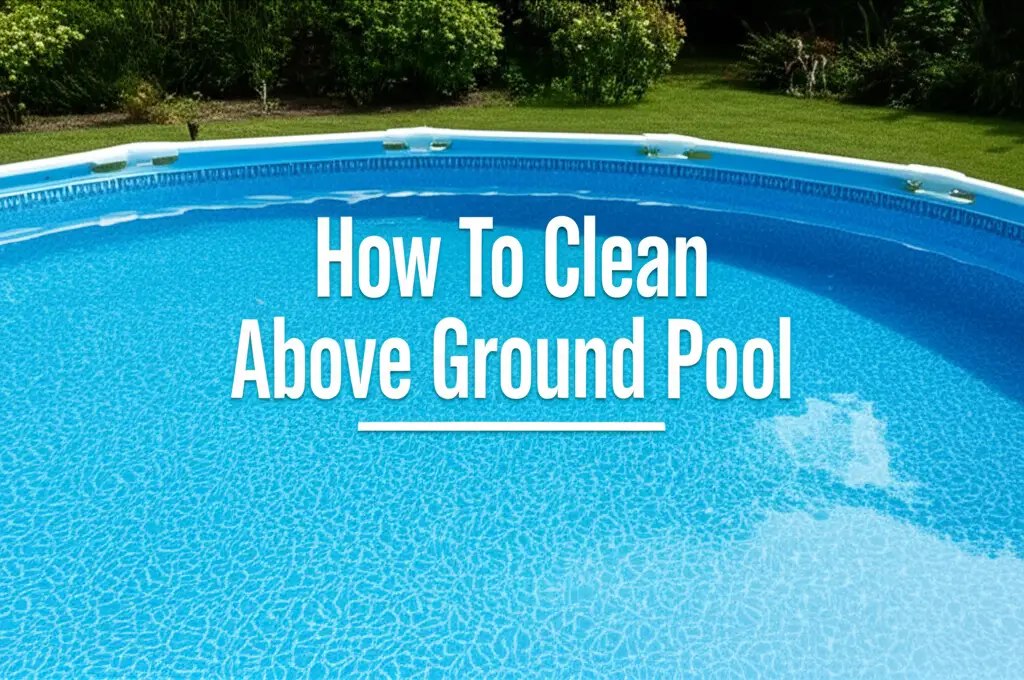
Keep Your Oasis Sparkling: How To Clean Above Ground Pool Effectively
Your above ground pool offers a wonderful escape during warm months. It is a place for relaxation and fun. But to keep it inviting, consistent cleaning and maintenance are essential. Many pool owners wonder exactly how to clean above ground pool structures and water. You want your pool water clear and your pool free of debris. This guide will walk you through all the necessary steps. We will cover everything from daily tasks to solving common issues. You will learn how to maintain your above ground pool for endless summer enjoyment.
Takeaway:
- Regular skimming, brushing, and vacuuming prevent debris buildup.
- Balanced water chemistry (pH, alkalinity, sanitizer) is crucial for water clarity and health.
- Proper filter and pump maintenance ensures efficient water circulation and filtration.
- Address common issues like algae and cloudiness promptly with targeted treatments.
- Follow seasonal cleaning routines for opening and closing your pool.
To clean an above ground pool effectively, regularly skim debris, brush surfaces, vacuum the bottom, and maintain proper water chemistry. This involves testing pH, alkalinity, and sanitizer levels, and cleaning the filter system to ensure clear, healthy water.
Understanding Your Above Ground Pool’s Cleaning Needs
Maintaining an above ground pool involves a few key areas. You must manage debris, water chemistry, and equipment. Each part plays a vital role in keeping your pool clean and safe. Ignoring one area can affect the others. For instance, poor filtration can lead to cloudy water. Unbalanced chemicals can cause algae growth.
Above ground pools are popular for their affordability and easier installation. However, they still require regular attention. Debris like leaves, insects, and dirt often fall into the water. These items introduce unwanted contaminants. They can also affect your water’s chemical balance. My own experience taught me that a little effort daily saves a lot of trouble later.
The pool’s filter system works hard to remove small particles. The pump moves water through the filter. If your filter is dirty, it cannot clean effectively. If your pump fails, water stops moving. Understanding these connections helps you clean your pool efficiently. We will explore each aspect in detail. This ensures your pool stays pristine all season long.
Essential Tools and Supplies for Above Ground Pool Cleaning
Having the right tools makes pool cleaning much easier. You do not need a lot of expensive equipment. A few basic items will get the job done. I always keep my tools organized. This way, I am ready when my pool needs attention. Gathering these supplies before you start saves time.
Here are the essential items you will need:
- Pool Skimmer Net: This net attaches to a telescopic pole. You use it to remove floating debris. Leaves, bugs, and twigs are easily scooped out. Daily skimming prevents organic matter from sinking.
- Pool Brush: A brush also attaches to the telescopic pole. You use it to scrub the pool walls and bottom. This removes dirt, grime, and budding algae. Regular brushing keeps surfaces smooth and clean.
- Pool Vacuum: There are manual, suction, and robotic vacuums.
- Manual vacuums connect to your filter pump or garden hose. You push them across the bottom.
- Suction vacuums attach to your skimmer opening. The pump’s suction pulls debris into the filter.
- Robotic vacuums operate independently. They move on their own and collect debris. Choose one that fits your budget and pool size. You can learn how to effectively clean the bottom of your pool without draining using these tools.
- Telescopic Pole: This adjustable pole is vital. It allows you to reach all areas of your pool. Your skimmer, brush, and vacuum head attach to it.
- Water Test Kit or Strips: These are essential for checking water chemistry. They measure levels like pH, chlorine, and alkalinity. Accurate testing helps you balance chemicals correctly.
- Pool Chemicals: You will need various chemicals.
- Chlorine (or other sanitizer): Keeps water free of bacteria and algae.
- pH Increaser/Decreaser: Adjusts the water’s acidity or basicity.
- Alkalinity Increaser: Stabilizes pH levels.
- Calcium Hardness Increaser: Prevents corrosion and plaster damage.
- Algaecide: Prevents or treats algae growth.
- Pool Shock: Oxidizes contaminants and boosts sanitizer levels.
Having these items on hand ensures you are prepared for regular maintenance. They help you address any unexpected issues quickly. This proactive approach keeps your above ground pool clean and enjoyable.
Daily and Weekly Above Ground Pool Cleaning Rituals
Consistent cleaning prevents major problems. I find a routine makes pool maintenance simple. Breaking tasks into daily and weekly duties helps. This ensures nothing gets overlooked. It also keeps your water sparkling.
Daily Tasks
Every day, you should perform a few quick checks and actions. These steps take very little time. They make a big difference in water clarity.
- Skim the Surface: Use your skimmer net to remove floating debris. Leaves, insects, and pollen can quickly accumulate. Removing them prevents them from sinking. This also keeps your filter from working harder. I often do this first thing in the morning.
- Check Water Level: Ensure your water level is appropriate. It should be about halfway up the skimmer opening. This allows your skimmer to work properly. Add water if necessary.
Weekly Tasks
Once a week, you need to do a more thorough cleaning. These tasks ensure your pool stays healthy. They prevent issues like algae and cloudy water.
- Brush Pool Walls and Bottom: Use your pool brush to scrub all surfaces. Pay attention to corners and ladders. Algae and dirt can cling to the liner. Brushing loosens these contaminants. Your filter system can then remove them. This is an important step to prevent algae buildup.
- Vacuum the Pool: This removes settled debris from the bottom.
- Manual Vacuuming: Connect your vacuum head to the telescopic pole. Attach the hose to the skimmer opening or a dedicated vacuum port. Move the vacuum slowly across the bottom. This ensures all dirt gets picked up. You can learn more about how to effectively clean the bottom of your pool without draining.
- Automatic/Robotic Vacuuming: If you have an automatic cleaner, deploy it. Let it run its cycle. These cleaners save you time and effort.
- Empty Skimmer and Pump Baskets: Debris collects in these baskets. Empty them regularly. This ensures good water flow. A full skimmer basket restricts suction. A full pump basket can damage your pump.
- Backwash or Clean Filter: Your filter collects all the small particles. It needs regular cleaning to work efficiently.
- For sand filters, you will backwash. This reverses water flow to flush out trapped debris. You can find detailed instructions on how to clean a sand filter for an above ground pool.
- For cartridge filters, you will remove and rinse the cartridge. Sometimes, a deep chemical cleaning is needed. Learn how to perform this by reviewing how to clean a pool cartridge filter.
- For D.E. filters, you will backwash and add new D.E. powder.
- Test Water Chemistry: This is critical. Use test strips or a liquid test kit. Check pH, alkalinity, and sanitizer levels. Adjust chemicals as needed. We will discuss water chemistry in the next section.
- Shock the Pool (as needed): If you had heavy use, rain, or notice cloudy water, shock your pool. Shocking oxidizes contaminants. It boosts chlorine levels.
Following these routines helps maintain a clean and healthy above ground pool. It also reduces the chances of bigger problems later on.
Mastering Above Ground Pool Water Chemistry
Water chemistry is the backbone of a clean and healthy pool. You cannot just clean visible dirt. You must also manage invisible elements. Balanced water chemistry prevents algae, cloudy water, and equipment damage. I learned early on that skipping this step leads to bigger headaches.
The main parameters you need to monitor are:
- pH Level: This measures the acidity or basicity of your water. The ideal range is 7.4 to 7.6.
- High pH (above 7.6): Can cause cloudy water, scale buildup, and reduce sanitizer effectiveness. You lower pH using muriatic acid or sodium bisulfate.
- Low pH (below 7.4): Can cause eye and skin irritation. It can also corrode pool equipment. You raise pH using sodium carbonate (soda ash).
- Total Alkalinity (TA): TA acts as a buffer for your pH. It helps keep pH stable. The ideal range is 80-120 ppm (parts per million).
- High TA: Makes pH difficult to adjust. It can cause cloudy water. You lower TA by adding muriatic acid in small increments.
- Low TA: Causes pH to fluctuate wildly. It can make the water corrosive. You raise TA using sodium bicarbonate (baking soda).
- Sanitizer Level (Chlorine, Bromine, etc.): This kills bacteria and algae. For chlorine, the ideal range is 1-3 ppm for free chlorine.
- Low Sanitizer: Allows bacteria and algae to grow. Your water will turn green or cloudy. Add more sanitizer or shock the pool.
- High Sanitizer: Can cause eye/skin irritation and bleach pool liners. Reduce levels by stopping sanitizer addition, or using a neutralizer. Sunlight also helps dissipate chlorine.
- Calcium Hardness (CH): This measures the amount of dissolved calcium in your water. The ideal range for above ground pools is 150-250 ppm.
- Low CH: Makes water “soft” or corrosive. It can leach calcium from pool surfaces. This can damage liners and equipment. Raise CH using calcium chloride.
- High CH: Can cause scale buildup on surfaces and equipment. This makes water cloudy. You can lower it by partially draining and refilling with softer water.
How to Test Water Chemistry
You will use a water test kit or test strips. I prefer liquid test kits for accuracy.
- Collect Water Sample: Dip your test strip or collection vial into the pool water. Go elbow deep.
- Read Results: Compare the strip colors to the chart provided. For liquid kits, count the drops until the color changes.
- Adjust Chemicals: Add chemicals slowly. Follow product instructions carefully. Always add chemicals to water, not water to chemicals. Never mix different chemicals together. Re-test after a few hours or the next day. This confirms your adjustments are correct.
Regular water testing and balancing prevent many common pool problems. It keeps your water clear, safe, and pleasant for swimming.
Effective Filter and Pump Maintenance for Above Ground Pools
Your pool’s filter and pump are its heart and lungs. They work together to circulate and clean the water. Proper maintenance of these components is crucial. It ensures your pool stays free of contaminants. Neglecting them leads to cloudy water and expensive repairs. I learned to respect my filter early on.
Understanding Your Filter Type
Above ground pools commonly use one of three filter types:
- Sand Filters: These are popular for their simplicity and low maintenance. Water flows through a bed of specialized filter sand. The sand traps debris.
- Cleaning: You clean a sand filter by “backwashing.” This reverses the water flow. It flushes trapped debris out of the filter and into a waste line. Backwash when the pressure gauge rises 8-10 PSI above its normal operating pressure. This usually happens weekly or bi-weekly. Detailed instructions are available on how to clean a sand filter for an above ground pool.
- Sand Replacement: Sand typically needs replacement every 5-7 years.
- Cartridge Filters: These filters use a pleated fabric cartridge. The fabric captures very fine particles.
- Cleaning: To clean, you remove the cartridge. Hose it off thoroughly with a strong spray nozzle. Clean it when the pressure gauge rises 8-10 PSI above its normal operating pressure. I do this every 2-4 weeks during peak season. You can learn more about how to clean a pool cartridge filter.
- Deep Cleaning: Every 3-6 months, soak the cartridge in a chemical filter cleaner. This removes oils and mineral buildup.
- Cartridge Replacement: Cartridges typically last 1-3 years.
- Diatomaceous Earth (D.E.) Filters: These offer the finest filtration. Water passes through a fine powder (D.E.) coated onto fabric grids.
- Cleaning: D.E. filters also use backwashing. After backwashing, you must add new D.E. powder to the filter. The powder recoats the grids. Clean when the pressure gauge rises.
- Annual Cleaning: Disassemble and clean the grids annually. This removes trapped debris and ensures efficiency.
Pool Pump Maintenance
The pool pump draws water from the pool and pushes it through the filter. It is crucial for circulation.
- Empty Pump Basket: Regularly check and empty the pump’s hair and lint basket. This prevents clogs and ensures good water flow. A full basket strains the pump.
- Inspect for Leaks: Periodically check all connections for leaks. Address any leaks promptly.
- Impeller Cleaning: If your pump loses suction, the impeller might be clogged. The impeller is inside the pump. It moves the water. You can find out how to clean an above ground pool pump impeller if you suspect a blockage. This usually involves shutting off power and accessing the pump housing.
- Run Time: Run your pump long enough each day. It should run long enough to cycle all the pool water at least once. This is typically 8-12 hours, depending on your pump size and pool volume. Consistent circulation helps keep water clean and chemicals distributed.
Proper filter and pump maintenance ensures your pool water remains clear and healthy. It also extends the life of your equipment.
Tackling Common Above Ground Pool Problems: Algae and Cloudiness
Even with regular cleaning, problems can arise. Algae and cloudy water are common issues for pool owners. They can turn your inviting oasis into an unsightly swamp. Knowing how to fix these problems saves frustration. I have dealt with both many times.
Dealing with Algae
Algae manifests in various colors: green, black, yellow (mustard), or pink (a bacteria, not true algae). Green algae is the most common. It turns your water green and makes surfaces slimy.
Here is how to tackle algae:
- Test Water Chemistry: First, check your pH and alkalinity. Ensure they are in the ideal ranges. Algae thrives in unbalanced water. Adjust as needed.
- Brush Vigorously: Use your pool brush to scrub all affected surfaces. Loosen as much algae as possible. This makes it easier for chemicals to work. Pay extra attention to shady areas.
- Shock the Pool: Super-chlorinate your pool. This means adding a high dose of chlorine.
- For light green algae, use a double dose of pool shock.
- For heavy green or black algae, use a triple or quadruple dose.
- Add shock at dusk or night. Sunlight reduces chlorine’s effectiveness.
- Run Filter Continuously: Keep your pool pump and filter running for 24-48 hours. This helps circulate the shock and filter out dead algae.
- Backwash/Clean Filter: The filter will quickly get clogged with dead algae. Backwash sand and D.E. filters or clean cartridge filters frequently. You might need to do this several times.
- Vacuum to Waste (if possible): After shocking and filtering, dead algae may settle. If your vacuum allows, vacuum directly to waste. This bypasses the filter. It removes the dead algae from the pool system entirely.
- Add Algaecide: After the water starts to clear, add algaecide. This helps prevent future growth. Do not add algaecide at the same time as shock. Wait at least 24 hours.
- Re-Test and Balance: Once the water is clear, re-test all chemical levels. Adjust as necessary. For a more in-depth guide on handling green water, refer to our article on how to clean an above ground pool with algae.
Clearing Cloudy Water
Cloudy water means tiny particles are suspended in your pool. It can result from:
- Poor Filtration: Your filter might be dirty, old, or too small.
- Unbalanced Chemistry: High pH, high alkalinity, or low sanitizer.
- High Total Dissolved Solids (TDS): Too many dissolved contaminants.
- Heavy Bather Load or Rain: Introduces more contaminants.
Here’s how to fix cloudy water:
- Test Water Chemistry: This is always the first step. Adjust pH, alkalinity, and sanitizer levels to their ideal ranges. Often, just correcting the chemistry clears up mild cloudiness.
- Clean Your Filter: A dirty filter cannot remove particles effectively. Backwash your sand or D.E. filter, or clean your cartridge filter. A clean filter is vital for clear water.
- Run Filter Longer: Increase your pump’s run time. Run it for 12-24 hours continuously. This gives the filter more time to work.
- Shock the Pool: A good shock can oxidize organic matter causing cloudiness. Follow the shocking procedure described above for algae.
- Use a Flocculant or Clarifier:
- Pool Clarifier: Coagulates tiny particles into larger ones. This makes it easier for your filter to trap them. Add clarifier according to product directions.
- Pool Flocculant (Floc): Causes particles to clump together and sink to the bottom. After adding floc, turn off your pump for 8-12 hours. Let everything settle. Then, vacuum the settled debris to waste. Floc is more aggressive but highly effective.
- Consider Draining and Refilling (as a last resort): If cloudiness persists despite all efforts, your pool water might have very high TDS. Draining part or all of the pool and refilling with fresh water might be necessary. This is especially true for older water.
Prompt action on algae and cloudy water prevents them from worsening. This keeps your above ground pool inviting and ready for fun.
Seasonal Above Ground Pool Cleaning: Opening and Closing
Seasonal cleaning is vital for above ground pools. Proper opening prepares your pool for summer fun. Correct closing protects it during winter. Both processes prevent major issues and save money. I always take my time with these steps. They are investments in future enjoyment.
Opening Your Above Ground Pool for Summer
Opening your pool properly sets the tone for the entire season. A good opening makes ongoing maintenance easier.
- Remove Pool Cover: Carefully remove your winter cover. Do this on a calm, non-windy day. Try to remove any accumulated debris or water from the top first. This prevents it from falling into the pool. Clean the cover thoroughly before storing it.
- Inspect Pool and Equipment: Look for any damage to the liner, skimmer, or return lines. Check the pump, filter, and hoses for cracks or leaks. Make any necessary repairs now.
- Fill Pool to Operating Level: If the water level is low, add fresh water until it reaches the middle of your skimmer opening.
- Reconnect Equipment: Reconnect the pump, filter, heater (if applicable), and any other accessories. Ensure all connections are tight. Open all valves.
- Start Pump and Filter: Turn on your pump and let it run. Check for leaks around connections. Backwash or clean your filter immediately. It might be dirty from sitting all winter. You can learn more about how to clean a pool after winter.
- Test and Balance Water Chemistry: This is the most crucial step. Test pH, alkalinity, calcium hardness, and sanitizer levels. Adjust them to their ideal ranges. The water might be green or cloudy from winter.
- Shock the Pool: Once your chemistry is balanced, shock the pool heavily. This kills any lingering bacteria or algae. Run the pump continuously for 24-48 hours.
- Brush and Vacuum: After shocking, brush the pool walls and bottom. Vacuum any settled debris. You may need to do this several times.
- Add Algaecide and Clarifier (if needed): Once the water clears, add a preventative dose of algaecide. A clarifier can help clear any lingering cloudiness.
Closing Your Above Ground Pool for Winter
Properly closing your pool protects it from freezing damage. It also makes opening easier next spring.
- Clean the Pool Thoroughly: This is critical. Skim, brush, and vacuum the pool. Remove all debris. A clean pool means less work in the spring. You can clean the bottom of your pool without draining it, which is ideal before winterizing.
- Balance Water Chemistry: Test and balance your water. Adjust pH, alkalinity, and calcium hardness. Your water should be balanced before adding winterizing chemicals.
- Add Winterizing Chemicals: Use a winterizing kit or individual chemicals. These typically include algaecide, a stain preventative, and a shock treatment. Follow the product instructions carefully.
- Lower Water Level (Optional, but recommended): For above ground pools, lower the water level below the skimmer and return lines. This prevents freezing damage to these components.
- Drain and Disconnect Equipment:
- Drain all water from your pump, filter, and heater.
- Disconnect hoses. Store them indoors if possible.
- Remove your skimmer basket.
- If you have a sand filter, consider putting the multi-port valve in the “winterize” or “closed” position. For cartridge filters, remove and clean the cartridge for storage.
- Plug Lines: Use winterizing plugs to seal the skimmer opening and return lines. This prevents water from entering and freezing.
- Cover the Pool: Install a secure winter cover. This protects the pool from debris and sunlight. It keeps the water cleaner over winter.
- Store Chemicals Safely: Store any remaining pool chemicals in a cool, dry, well-ventilated area.
Following these seasonal steps ensures your above ground pool remains in excellent condition year-round.
FAQ Section
How often should I vacuum my above ground pool?
You should vacuum your above ground pool at least once a week during peak swimming season. If you have heavy debris or frequent use, vacuuming twice a week may be necessary. Regular vacuuming helps keep the pool bottom clean and reduces the load on your filter system.
Can I clean an above ground pool without draining it?
Yes, you can absolutely clean an above ground pool without draining it. Routine cleaning tasks like skimming, brushing, and vacuuming are all done with water in the pool. You only need to drain your pool for major repairs, liner replacement, or extreme, persistent water issues.
How do I get rid of green algae in my above ground pool?
To get rid of green algae, first brush the pool surfaces to loosen the algae. Then, test and balance your water chemistry, especially pH and chlorine. Shock the pool with a high dose of chlorine. Run your filter continuously and clean it frequently as the algae dies and is filtered out.
What causes cloudy water in an above ground pool?
Cloudy water often results from unbalanced water chemistry (like high pH or low chlorine), a dirty or inefficient filter, or too many suspended particles (like dirt, pollen, or dead algae). Heavy rain or high bather loads can also contribute to cloudiness by introducing more contaminants into the water.
How often should I clean my pool filter?
The frequency of filter cleaning depends on your filter type and pool usage. For sand filters, backwash when the pressure gauge rises 8-10 PSI. For cartridge filters, rinse the cartridge every 2-4 weeks. D.E. filters also require backwashing when pressure rises and an annual full cleaning.
Do above ground pools need specific winterizing steps?
Yes, above ground pools require specific winterizing steps to protect them from freezing damage. This includes thorough cleaning, balancing water chemistry, adding winterizing chemicals, lowering the water level below skimmer/return lines, disconnecting and draining equipment, plugging lines, and securing a winter cover.
Conclusion
Keeping your above ground pool sparkling clean does not have to be a daunting task. By following a consistent routine, you can enjoy clear, inviting water all season long. Remember, regular skimming, brushing, and vacuuming are your first lines of defense against debris. Mastering your water chemistry, including pH, alkalinity, and sanitizer levels, is crucial for a healthy swimming environment. Always pay attention to your filter and pump, as they are the workhorses of your pool’s cleaning system.
By proactively addressing common issues like algae and cloudy water, and performing diligent seasonal maintenance for opening and closing, you ensure your above ground pool remains a source of joy. These simple steps will help you enjoy your pool more and worry less. So, grab your tools, test your water, and keep that above ground pool pristine! Happy swimming!
- above ground pool cleaning
- pool maintenance
- pool care
- pool filters
- water chemistry
- algae removal

